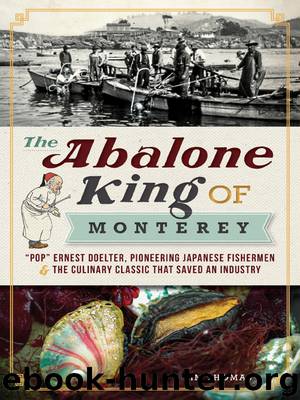The Abalone King of Monterey by Tim Thomas

Author:Tim Thomas
Language: eng
Format: epub
Publisher: The History Press
Published: 2014-03-14T16:00:00+00:00
Abalone boat getting ready to unload at the Monterey Wharf. Note the two dive suits draped over the pole so they can dry. Circa 1938. City of Monterey, California History Room.
Monterey Abalone diver Roy Hattori returning to the surface after a three-hour dive. The man standing in the boat in the hat is Roy’s brother, James, and the other man, with his foot on the ladder, is Ishio Enokida, one of the “tenders” on the boat. Everyone called him “Ish.” Circa 1938. City of Monterey, California History Room.
Each diver had his own technique to collect abalone. Some would literally “run” once they hit bottom or “duck-walk” or crawl. There was one diver in Monterey who would slither on his stomach like a snake. The idea is not to disturb the abalone but rather to sneak up on them so you can pick them up before they latch on to the rock. Monterey abalone diver Roy Hattori, who was the only diver born in Monterey (all the other divers came from Japan and, with just a few exceptions, returned to Japan) told this author, “You have to run on the bottom to find abalone. And it’s not easy. In the very beginning, you tend to use a lot of energy working against the water. But as you get more and more used to diving and get a little more skillful, you learn to use the currents and you learn to use the surge to give you the necessary impetus to travel a little bit faster and easier.”
The diver would put the abalone into his basket. Once the basket was full, he would give a signal that he had a full basket by pulling on his lifeline; each diver had their own set of signals. According to Roy:
Depending on the size of the abalone, with good-size abalone you get maybe thirteen, fourteen at the most. If you were in a good spot, you would cram the abalone in. In the first place, if you hit a good spot, you would open up the bottom, re-tie the bottom. The bottom opens on these, see. That’s how they get the abalone out. They don’t pull ’em out through the top. The bottom is made so that you can open it up as much as you want, as long as the abalone doesn’t fall through. And so you open up the bottom, you could get maybe 50 percent more abalone just by opening up the bottom to the maximum, where the abalone wouldn’t fall through but you could get in everything that you could. And that way, the people around you wouldn’t see how many baskets you were putting up. Depending on the boat, some crews carried three men on top. Some carried four men on top, but most of the time, it was three men on top. One man on the scull, and one man tending with the lifeline and one man helping to pull the abalone baskets on board and to measure and to store the abalone into the hold of the diving tender.
Download
This site does not store any files on its server. We only index and link to content provided by other sites. Please contact the content providers to delete copyright contents if any and email us, we'll remove relevant links or contents immediately.
| Cajun & Creole | California |
| Hawaiian | Mid-Atlantic |
| Midwestern | New England |
| Northwestern | Soul Food |
| Southern | Southwestern |
| Western |
Biscuits: A Savor the South Cookbook by Belinda Ellis(3901)
Al Roker's Hassle-Free Holiday Cookbook by Al Roker(3175)
A Jewish Baker's Pastry Secrets: Recipes from a New York Baking Legend for Strudel, Stollen, Danishes, Puff Pastry, and More by George Greenstein(3100)
Ottolenghi Simple by Yotam Ottolenghi(3035)
Trullo by Tim Siadatan(2984)
The French Women Don't Get Fat Cookbook by Mireille Guiliano(2975)
Better Homes and Gardens New Cookbook by Better Homes & Gardens(2948)
Bake with Anna Olson by Anna Olson(2928)
Panini by Carlo Middione(2823)
Hot Thai Kitchen by Pailin Chongchitnant(2803)
Nigella Bites (Nigella Collection) by Nigella Lawson(2768)
Momofuku by David Chang(2761)
Modern French Pastry: Innovative Techniques, Tools and Design by Cheryl Wakerhauser(2722)
Salt, Fat, Acid, Heat: Mastering the Elements of Good Cooking by Nosrat Samin(2652)
Tapas Revolution by Omar Allibhoy(2531)
Classic by Mary Berry(2499)
Solo Food by Janneke Vreugdenhil(2489)
Best of Jane Grigson by Jane Grigson(2466)
Okonomiyaki: Japanese Comfort Food by Saito Yoshio(2387)
